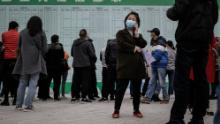By the end of the year, China’s share of global GDP is likely to rise by about 1.1 percentage points, according to a CNN Business calculation using World Bank data. That’s more than triple the share it gained in 2019. By contrast, the United States and Europe will see their shares dip slightly.
All told, China’s economy is expected to be worth about $14.6 trillion by the end of 2020, roughly equivalent to 17.5% of global GDP.
Even without the disruption caused by the virus, China’s share would have ticked up this year, according to Larry Hu, chief China economist for Macquarie Group. But China’s ability to buck the worldwide trend is accelerating the growth in its importance to the global economy.
“The recovery in China has been much stronger than the rest of the world,” Hu added.
A Golden Week boom
The economic improvement has been no more apparent than during this past week, when the country celebrated one of its annual Golden Week holidays. This season’s festivities marked the founding of the People’s Republic of China and the Moon Festival, and was one of the country’s busiest travel seasons of the year.
More than 630 million people traveled around the country during Golden Week, which ended Thursday, according to the Ministry of Culture and Tourism. That’s nearly 80% of the numbers who traveled during the same period last year.
The holiday week’s numbers are “encouraging,” said Macquarie’s Hu.
“As life is returning to normal in mainland China, consumption, especially the service consumption, is under recovery,” he said, added that pent-up demand has finally been unleashed.
A more balanced recovery
Even before the holiday, China’s economy had been picking up momentum.
An official gauge of manufacturing activity rose to a six-month high in September. A private survey from the media group Caixin, which measures smaller businesses, also showed the sector continued to expand last month.
The services sector is also doing well. An official survey released last week put activity at its highest level in nearly seven years. And on Friday, a Caixin survey revealed that services experienced one of the quickest paces of expansion in the past decade in September.
“Overall, the economy remained in a post-epidemic recovery phase and improved at a faster pace,” Wang Zhe, senior economist at Caixin Insight Group, said in a report accompanying Friday’s data.
Consumer spending is rebounding, too, in yet another encouraging sign. Economists were concerned earlier this year that China’s recovery was too unbalanced, having been driven by lots of state-led infrastructure projects and not enough consumer spending.
And despite trade tensions, China’s economy has also benefited from its vital role in global supply chains, according to Louis Kuijs, chief Asia economist at Oxford Economics. The research and advisory group’s own calculations also indicate that China will increase its share of global GDP by about a percentage point this year.
“Even as US-China tensions have worsened dramatically recently, many US multinationals remain keen to engage with China,” Kujis said, adding that American firms were likely encouraged by Beijing’s decision to remove some barriers to investing in the country’s financial sector.
Challenges ahead
While China’s recovery has been strong, there are challenges ahead.
Like in other countries, the pandemic has taken a heavy toll on China’s poor and rural populations, according to the Fitch Ratings analysts.
And low-income households in China — those who make less than $7,350 a year — experienced the most severe declines in family wealth out of any other income group, according to a survey jointly conducted by China’s Southwestern University of Finance and Economics and Ant Group’s research institute.
“This suggests the recent recovery in consumption is likely to have been somewhat skewed towards higher-income groups,” the Fitch Ratings analysts said.
And Kuijs of Oxford Economics said that US-China tensions remain a concern, even as foreign direct investment grows.
If the United States were to decouple “significantly from China,” the country’s growth would trend less than half a percentage point lower per year through 2040, he said, as long as other developed countries maintained most ties.
But if other developed countries join the United States, he suspected that impact could be much larger, causing China’s GDP growth to fall twice as fast through the same period.
That kind of “substantial” decoupling “would sharply reduce the country’s productivity and GDP growth,” Kuijs said.
Source : Nbcnewyork
















